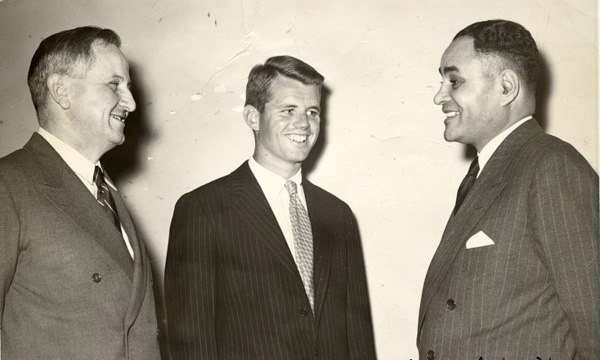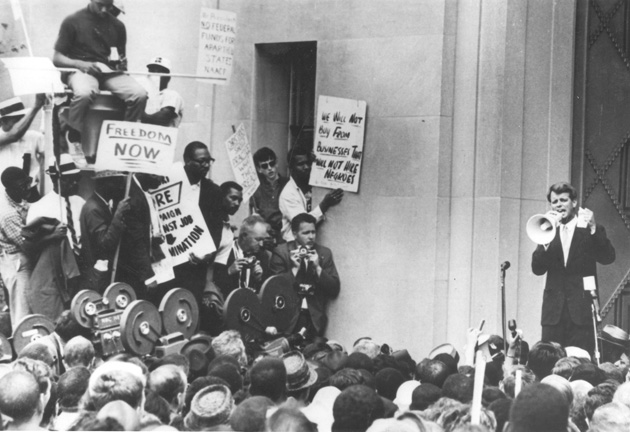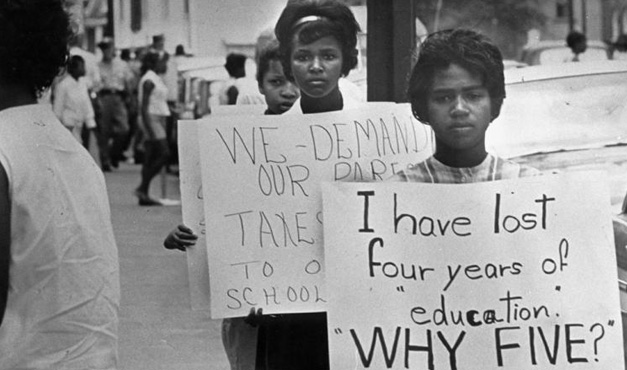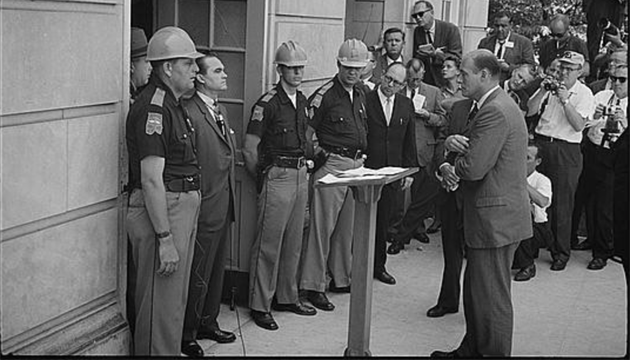It should be clear that, if one man’s rights are denied, the rights of all are in danger–that if one man is denied equal protection of the law, we cannot be sure that we will enjoy freedom of speech or any other of our fundamental rights.
A well-organized, non-violent civil rights’ movement had been waging war on racial discrimination in the United States for decades. However, despite important legal victories and a growing national sentiment against white supremacy, there was limited progress toward true racial equality. Active-resistance to racial integration persisted throughout all walks of life: in schools, at the workplace, in sports arenas, lunch counters and most all public places.
civil rights noun the rights that every person should have regardless of his or her sex, race or religion; see Civil Rights Movement timeline
During the tumultuous era of the 1960’s, Robert Kennedy was one of most vocal and relentless champions of civil rights. As he spoke out against racial injustice in every walk of life, his words and actions inspired countless men, women and children of all races, religions and backgrounds to find their higher selves in the pursuit of equality for all.
What we need in the United States is not division; what we need in the United States is not hatred; what we need in the United States is not violence and lawlessness, but is love, and wisdom, and compassion toward one another, and a feeling of justice toward those who still suffer within our country, whether they be white or whether they be black.
Through his personal conviction and work as an attorney and public servant, Robert Kennedy lashed out against racial discrimination wherever it refused to die.
Throughout the 1950’s and 1960’s, Kennedy and his team worked tirelessly to enforce often-ignored federal laws that had been intended to integrate the nation. One of Kennedy’s greatest areas of impact was in his demand for the integration of public education from kindergarten to the university level.
Taking on School Segregation
1. 1951 | Dr. Ralphe Bunche Speaks at the University of Virginia 
In 1951, Robert Kennedy took a strong stand for civil rights while a law school student at the University of Virginia (UVA) in Charlottesville, VA. Although the UVA was still segregated at the time, Kennedy knowingly created controversy by inviting Dr. Ralph Bunche, the first African
American and person of color to receive the Nobel Peace prize, to speak as an honored guest at the University of Virginia. Dr. Bunche accepted the invitation to speak, although on the condition that he was only willing to appear before a racially integrated audience. This infuriated many students and community members. In the end, the school’s leadership cited a the Supreme Court ruling that had banned segregation in higher education and allowed Dr. Bunche to speak on campus to an integrated crowd.
In the following clip, Robert Kennedy’s wife, Ethel, reflects with her youngest daughter and film narrator, Rory, about the courage required of Kennedy to defy those who were angered by his inviting a man of color to speak at the University of Virginia
In 1954, the Supreme Court had ruled in the case of Brown v. Board of Education (link here to Brown v. Board background info) that ‘separate was not equal’ in classrooms anywhere. However, in many areas of the South attempts to enforce integration were often met with resistance and even violence. In Virginia, U.S. Senator Harry F. Byrd, Sr. declared a policy of Massive Resistance. His goal was to unite other white politicians and leaders in a campaign toward new state laws and policies that would prevent public school desegregation. This sent a message throughout entire state of Virginia that there would be no integration anywhere.
To avoid having to integrate public schools, the Prince Edward County school board actually closed-down the schools. At the same time, the Prince Edward Foundation was created as a series of private schools designed to educate the county’s white children. However, no provisions were made to educate the county’s black children.
As Attorney General of the United States, Robert Kennedy took decisive and dramatic action to assure the integration of the Prince Edward County schools. Learn about the closing of the schools and the civil rights battles that went on around through this interactive timeline.
3. 1963 | Integration of the University of Alabama
In April, 1963 Attorney General Robert F. Kennedy traveled to Alabama to try to convince Governor George Wallace to stop discriminating against black people in schools and elsewhere. Wallace refused. Robert Kennedy and his brother, President John F. Kennedy, pressed on against the Governor and eventually ordered Wallace to allow black students to register at the University of Alabama. However, Wallace continued to resist their demands.
Two months later, Governor George Wallace protested the integration of two black students into the all-white University of Alabama. In what is now known as the ‘Stand in the Schoolhouse Door”, Wallace literally stood in the doorway in resistance to federal authorities who were trying to pave the way for students to enter. When he refused to move, President John F. Kennedy dispatched 100 National Guard troops to assist. Eventually, Wallace relented and the students enrolled without violence.
Promoting A Non-Violent Approach to Civil Rights
1. 1968 | The Death of Dr. Martin Luther King Jr.
On April 4, 1968, shortly after civil rights leader Martin Luther King was tragically assassinated, Robert Kennedy arrived in Indianapolis for what was supposed to have been a campaign rally for his bid to become the Democratic nominee for President of the United States. Upon learning of the news of Martin Luther King’s murder, Kennedy was advised to cancel his appearance in the heart of the city’s ghetto for fear of a potential outbreak of violence, especially if a white man were to break the tragic news to an audience of nearly 1000, primarily African Americans who had not yet be informed of Dr. King’s murder. Kennedy ignored the warning and instead chose to address the crowd. Robert Kennedy’s heartfelt words comforted and reassured to a huge crowd of distraught supporters were stunned by the tragic news he shared.
2. 1968 | On the Mindless Menace of Violence
Following the assassination of Martin Luther King, angry protests and riots broke out throughout the country. Robert Kennedy cancelled his regular campaign schedule and instead, in an address in Cleveland, delivered a passionate plea for non-violence.
Promoting the Rights of All Minorities
Although African-Americans were the central focus of the civil rights movement, Kennedy lent support to all marginalized minorities. He was especially passionate about improving the lot of Native American Indians.
Before European ships landed on the shores of North America, millions of indigenous people lived throughout the land that would come to be known as the United States. Colonists and then the government, hungry for land, and resources, would begin to wage a war against the native peoples that would end in extermination comparable to genocide, or at the very least ethnocide and the deaths of the majority of the natives. During the 1960’s when Bobby worked with the Bureau of Land Management as the Attorney General, he did is best to try to work for the Native Americans, which he believed deserved the help of the United Sates government dearly.



